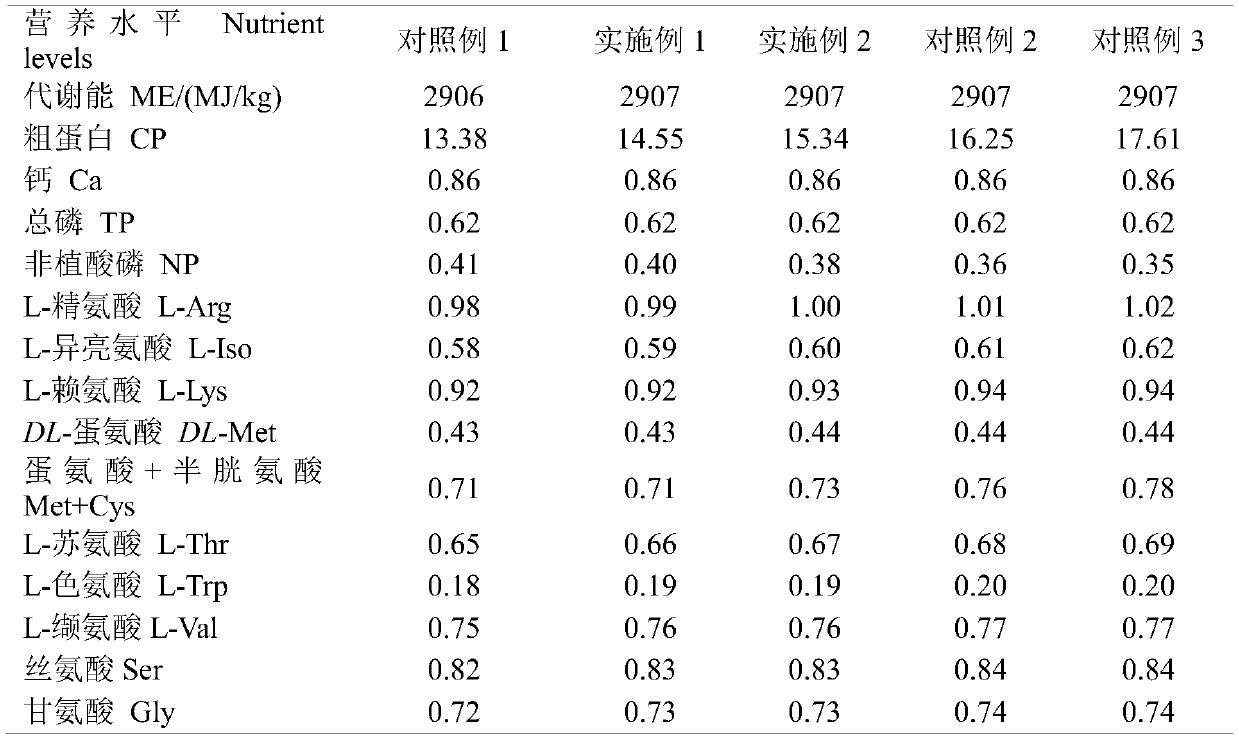Meat duck low-protein daily ration and application thereof
A low-protein, meat duck technology, applied in application, animal feed, additional food elements, etc., can solve the problems of high nitrogen content in duck manure, low feed utilization rate, high crude protein content, etc., to achieve full utilization and improve utilization rate , the effect of reducing crude protein content
- Summary
- Abstract
- Description
- Claims
- Application Information
AI Technical Summary
Problems solved by technology
Method used
Image
Examples
Embodiment 1
[0025] Present embodiment is a kind of meat duck low-protein diet, and this meat duck low-protein diet comprises the raw material of following weight portion:
[0026] 137.2g soybean meal, 751.8g corn, 44g rapeseed meal, 8g soybean oil, 15.7g calcium hydrogen phosphate, 11.4g stone powder, 10g premix, 3g salt, 1.8g DL-methionine, 3.12g L-lysine, L- Threonine 1.02g, L-isoleucine 0.96g, L-arginine 1.8g, L-tryptophan 0.3g, L-valine 1.2g, glycine 1.26g, serine 1.44g, compound enzyme preparation 1g and 0.5% chromium trioxide 5g, of which:
[0027] Each gram of premix includes: VA 1000IU, VB 1 0.2mg, VB 2 0.5mg, VB 5 0.4mg, VB 6 0.4mg, VB 12 0.2mg, VD 3 400IU, VE 2IU, VK 3 0.25mg, biotin 0.05mg, folic acid 0.3mg, D-pantothenic acid 2mg, niacin 2mg, Cu 1mg, Fe 10mg, Mn 6mg, Zn 10mg, I 0.1mg, Se 0.04mg and choline chloride 50mg;
[0028] Every gram of compound enzyme preparation includes phytase 368U, protease 2619U, amylase 314U, xylanase 138U and glucanase 344U.
[0...
Embodiment 2
[0031] Present embodiment is a kind of meat duck low-protein diet, and this meat duck low-protein diet comprises the raw material of following weight portion:
[0032] 155.8g soybean meal, 721.2g corn, 56g rapeseed meal, 12g soybean oil, 14.8g calcium hydrogen phosphate, 11.6g stone powder, 10g premix, 3g salt, DL-methionine 1.7g, L-lysine 2.58g, L- Threonine 0.68g, L-isoleucine 0.64g, L-arginine 1.2g, L-tryptophan 0.2g, L-valine 0.8g, glycine 0.84g, serine 0.96g, compound enzyme preparation 1g and 0.5% chromium trioxide 5g, of which:
[0033] Each gram of premix includes: VA 1000IU, VB 1 0.2mg, VB 2 0.5mg, VB 5 0.4mg, VB 6 0.4mg, VB 12 0.2mg, VD 3 400IU, VE 2IU, VK 3 0.25mg, biotin 0.05mg, folic acid 0.3mg, D-pantothenic acid 2mg, niacin 2mg, Cu 1mg, Fe 10mg, Mn 6mg, Zn 10mg, I 0.1mg, Se 0.04mg and choline chloride 50mg;
[0034] Every gram of compound enzyme preparation includes phytase 368U, protease 2619U, amylase 314U, xylanase 138U and glucanase 344U.
[...
experiment example
[0058] Test design
[0059] Randomly divide 1,000 1-day-old Peking ducks into 60 pens with controllable environmental temperature, and feed 20 ducks in each pen. The size of each pen is 200cm×120cm×40cm. The feeding period is 21 days. The routine diet of Peking ducks in the early growth stage. At the age of 21 days, select 300 healthy Peking ducks with the same weight and size, and randomly divide the selected 300 21-day-old Peking ducks into 5 treatment groups, each treatment group has 6 repetitions, and each repetition has 10 ducks , the feeding period is 21 days old to 42 days old; 5 treatment groups adopt respectively the meat duck low-protein diet in embodiment 1,2 and control example 1,2,3 to feed;
[0060] Experimental material and diet
[0061] The nutrient levels of different meat duck low-protein diets in embodiment 1,2 and comparative example 1,2 are as shown in table 1.
[0062] Table 1 Diet nutritional levels of different embodiments
[0063]
[0064] Feedi...
PUM
 Login to View More
Login to View More Abstract
Description
Claims
Application Information
 Login to View More
Login to View More - R&D
- Intellectual Property
- Life Sciences
- Materials
- Tech Scout
- Unparalleled Data Quality
- Higher Quality Content
- 60% Fewer Hallucinations
Browse by: Latest US Patents, China's latest patents, Technical Efficacy Thesaurus, Application Domain, Technology Topic, Popular Technical Reports.
© 2025 PatSnap. All rights reserved.Legal|Privacy policy|Modern Slavery Act Transparency Statement|Sitemap|About US| Contact US: help@patsnap.com



